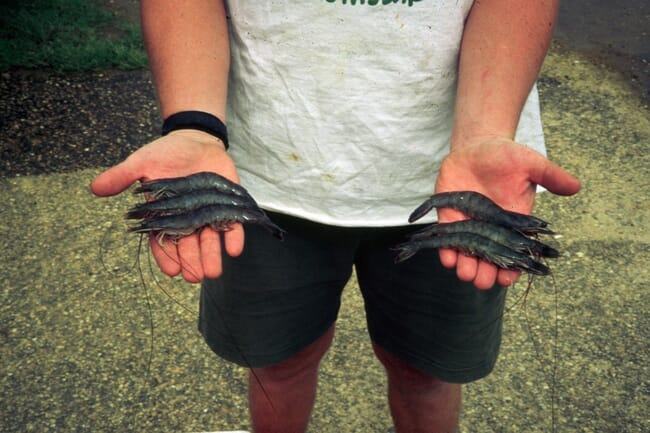
The increase in damming of large and important rivers such as the Nile in Africa and the Mekong in Asia have caused increased awareness of the negative effects of saltwater intrusion into parts of rivers that normally remain unaffected by salinity. In addition, due to rising sea levels and the increase in unusual weather events, such as tsunamis and hurricanes, saltwater inundation of coastal land is becoming more frequent and widespread. Brackish water shrimp aquaculture in countries such as Vietnam has been reported to be reduced by 50 percent, with salinities increasing to over 30 parts per thousand (ppt), close to the 35 ppt in standard seawater.
Fortunately, saline intolerant species of shrimp and fish that are currently being cultivated may be able to be replaced with more salt tolerant strains. Salinity tolerance is both very heritable within species and highly variable between species. Many saline tolerant freshwater species can also reproduce in brackish water, making biosecurity a possibility by completely closing the loop in the life cycle.
Maintaining a specific salt concentration in the blood is a necessity for normal growth and metabolism of aquaculture species. Growing fish or shrimp outside their preferred salinity range generally means reduced levels of growth and survival, contributing to a decrease in the potential profit of an aquaculture operation. A better option may be to choose species and strains that are better adapted to living in brackish water. Identifying freshwater species that are amenable to brackish water culture and seawater species able to grow in hypersaline environments may help to expand aquaculture areas that are negatively affected by saltwater intrusion.
Freshwater species grown in saltwater
Rice, which is the most common crop grown in delta regions and the one that people depend on for a major source of nutrition in most Asian countries, is considered the most salt intolerant cereal crop. Alternative options that have been presented in economic studies, including common shrimp varieties, that have been calculated to have a profit potential 12 times greater to that of rice. This is one example of aquaculture replacing more traditional agriculture in areas of saltwater intrusion. Further to this, there may be considerable potential to expand on the idea of adding undeveloped freshwater fish and shrimp species that can grow in brackish water.
Freshwater fish vary greatly in their ability to grow and survive in saltwater. Many common fishes from the carp family, such as the goldfish, can survive brackish water up to 10 ppt without difficulty. However, other important freshwater fishes such as the air breathing catfish (C.batrachus), commonly grown in aquaculture ponds in Asia, have very low tolerance to salinity, with 4 ppt leading to reduced growth and survival in research studies. Alternatively, the blue catfish (I. furcatus), the hybrid of which is one of the most important aquaculture species in the US, can survive and grow well in salinities up to 10 ppt and the culture of this fish may become important in areas of saltwater intrusion. The European perch (P. fluviatilis), which is an economically important species, has also been documented to survive and grow at a salinity of 10 ppt and so these are some very good examples of salt tolerant species normally grown in freshwater that could be suitable for brackish water culture.
Tilapia species and tilapia hybrids are some of the most widely cultured fish on the planet. The Nile tilapia grows as well in in saltwater up to 10 ppt as it does in fresh water. In addition, Nile and aureus hybrids have been reported to grow well in brackish water up to 18 ppt and various Nile hybrids can even reproduce at 18 ppt. Moreover, Mozambique varieties have better survival and growth in salinities of 10 ppt, as this fish is widely known as one of most saltwater adapted of any of the tilapia varieties. Research into saltwater tolerance of the Mozambique tilapia has proven that the offspring could only tolerate low salinity brackish water, while the adults could be grown in full strength seawater.
Although considered strictly a freshwater species, species of the freshwater shrimp Macrobrachium
have been determined, through controlled research studies, to grow and survive maximally at 10 ppt when produced in salinities ranging from 0 to 25 ppt. This crustacean species may be a viable option for culture in areas that are sometimes inundated with saltwater, which may kill other salt intolerant freshwater crustacean varieties. The red swamp crayfish (P.clarkii) commonly grown in southern US states, can easily survive moderate salinities and so this may be another crustacean species replacement option in areas of saltwater intrusion.

The blue shrimp (L. stylirostris) grew larger than the white shimp (L. vannamei), when grown together in the same pond during the same period of time (picture from author's graduate research in 1997) © Dr Bill McGraw
Growth and survival of saltwater species in hypersaline water
The two most commonly grown shrimp, L. vannamei, and P. monodon can survive and grow at salinities from 0.5 to 40 ppt and so strains can be selected that show higher salinity tolerance. L. stylirostris (blue shrimp) varieties can be grown successfully at a salinity as a high as 50 ppt, outperforming the other two more common varieties in hypersaline water. Increased saltwater intrusion in certain areas may see a resurgence in the popularity of the salt tolerant varieties of L. stylirostris.
As additional energy is required for osmoregulation in species grown in suboptimal salinities, growth at the far end of this range for genetic varieties not selected for tolerance to hypersaline water and species not adapted to hypersaline water, will likely decrease by 20-50 percent. Alternatively, increasing docosahexaenoic acid (DHA) and eicosapentaenoic acid (EPA) levels in prepared diets of shrimp has been shown to increase growth at salinities greater than 40 ppt, which are otherwise considered stressful for the most widely cultured varieties of shrimp.
Artemia are used intensively in the production of shrimp and fish around the world and can easily be grown in salinities up to 200 ppt. The numbers of artemia eggs that are freeze-dried and stored for fish and shrimp hatcheries have steadily increased over the last few decades and so artemia egg production may be a viable alternative compared to hypersaline intolerant species.
A physical adaptation to hypersaline waters is to increase the number of chloride cells responsible for maintaining salt concentrations in the blood of hybrid species of tilapia. High salinity tolerance can be increased in tilapia through selection, as the genes responsible for an increase in chloride cells have good heritable characteristics. Growth studies have shown no differences in growth rates between certain strains of tilapia in brackish and freshwater, indicating their potential use in commercial culture for areas affected by saltwater intrusion. Salinity tolerance generally increases when species are kept within their desired temperature range, so attention to proper temperature for growth is a necessity.
The development of new super hypersaline tolerant species
Very few species of fish and shellfish that are commercially valuable can survive salinities above 50 ppt. However, certain species of flounder (Rhombosolea tapirine), bream (Acanthopagrus butcheri) and mullet (Aldrichetta forsteri) have a proven resistance to hypersaline waters at 70 ppt, and so these species are potential candidates for further research into super hypersaline tolerance in aquaculture.
Some other species can tolerate salinities up to 100 ppt. Research on a species of ornamental fish (Poecilia latipinna) showed that very little osmotic stress is encountered beyond 60 ppt, and growth remains unaffected if salt levels surpass the salinity of normal seawater. Some super hypersaline tolerant fish have adapted to osmotic stress by actually limiting branchial water permeability. There are likely other more lesser-known species of fish that have adapted similarly and may become important commercially in areas greatly affected by saltwater intrusion.




